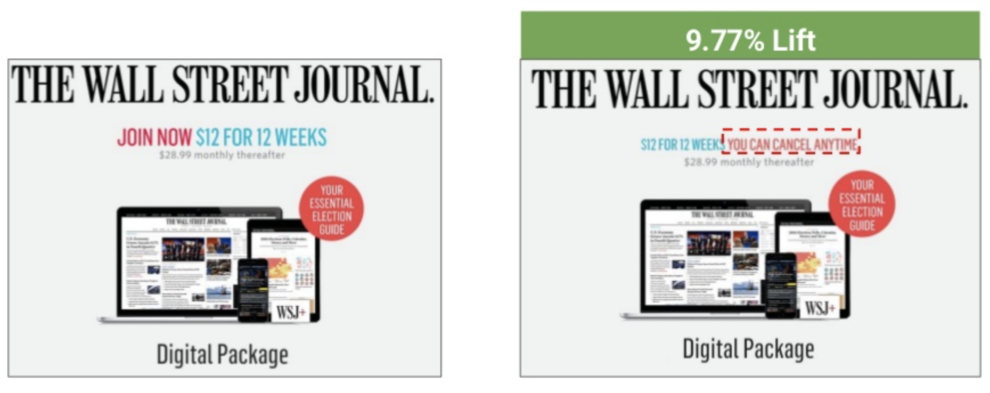|
Getting your Trinity Audio player ready...
|
Coming off recent industry discussions on the importance of product thinking, this week we are exploring three key ways publishers can reduce news product friction in their digital strategies.
Registration walls increase conversion
More and more publishers are adopting registration walls to help solve some of the new problems of today, including legal obligations, de-anonymizing users, and improved user experiences. We heard recently from Peter Doucette of FTI Consulting that he believes that registration walls are a matter of when, not if, for most publishers.
Today more and more legislation requires explicit user permissions, such as GDPR in the EU or CCPA in California. Many publishers have decided to abide by these rules through a variety of pop-ups asking for permissions, however this can impact the reading experience. Combine those pop-ups with the ever common newsletter signup pop-up (like the one you probably just closed), browser notification requests, and intrusive ads and it can take more than your readers are willing to tolerate before they actually are able to consume any content. By requiring users to log-in to access content, these pop-ups can be avoided since the user permissions will already be saved every time, no matter if they access from a new browser or device.
Furthermore, registration walls are a great tool for de-anonymising users. With the future looking like a third-party cookie-less world, this ability to gather data directly from users will be increasingly important, as will the ability to build a first-hand relationship with audiences. Of course, it also improves the publisher’s ability to market subscription offerings as well.
Finally, registration walls can help to ultimately reduce subscription friction down the line. It’s true that requiring users to give their email address to access content does provide a layer of friction, however it is a necessary layer that can increase conversions. To make the benefit of logging-in even more clear, some publishers today are offering features only to logged-in users such as commenting, saving articles, or a personalised feed. Ultimately it helps to reduce the friction at the moment of conversion since the reader does not have to create a new account or give their email address again when they decide to actually subscribe. This also ties into the importance of ‘incremental commitment’: it is psychologically easier to give a credit card number if you have already given an email address a while ago.
Clarity in language matters
The news media industry is interesting because almost everyone has personal experience of consuming news, which leads to them having an opinion on the industry. However there seems to be a bit of opaqueness surrounding the industry. Most readers don’t actually understand the realities of the news industry today. That is why it is key for newspapers to take the time to make sure they are communicating openly and clearly to their audiences. For example, the average layperson might not realise the newspaper industry is in a critical moment of change. When conducting reader interviews last year, we were surprised at how many said they didn’t understand why they were being asked to pay for a subscription when they were already “paying” through the advertising (even if they acknowledged they had an ad-blocker!).
This lesson can be applied to converting paid subscribers, something The Wall Street Journal did when they experimented with the language in their subscription offering ads. They found that they were often taking for granted certain benefits, so did not promote them when showing subscription offerings. For example, we’ve heard before about a feared “subscription fatigue”, and we know that signing up for a new subscription can be a bit anxiety-inducing. The Wall Street Journal was able to increase subscriptions 10% by simply highlighting the ease at which subscribers could cancel (which had no impact on the average tenure of subscribers).

We also have to be conscious of the terms we use to describe our readers. While membership programmes seem to be making a splash in Europe, with the success of The Guardian being a key standout, this term does not always translate in the United States. Mark Campbell, Chief Marketing Officer of Tribune Publishing, shared recently that their research shows American subscribers have viscerally negative reactions to being called ‘members’. This was backed up by Yasmin Namini, former Chief Consumer Officer at The New York Times, who explained that their subscribers thought if they were ‘members’ it meant they had to also agree with the editorial or opinion articles in the newspaper. It would be interesting to see if this is a cultural difference between the American and European news markets, or if it holds true in other regions as well. Still, this does not mean that American publishers cannot learn from successful European membership programmes, they just might need to avoid using the membership term explicitly.
At INMA’s third Subscription Summit last month, Yasmin Namini had further advice for publishers who are starting to explore a new paywall strategy. She believes that dynamic paywalls can be difficult to explain to readers, while hybrid models can be better explained. Having premium articles that are locked for subscribers only, with the rest being metered, makes it more clear to readers what value they would get from subscribing. Ultimately, it comes down to the fact that news organisations need to be transparent, not only with their coverage but also about their business models. With a dynamic paywall, how is a reader supposed to understand why they cannot access a story that their friend is able to access? During these discussions at the Summit, there seemed to be a divide between American and European publishers: American publishers had no qualms about dynamic price offers, with Newsday even adapting the billing cycle for each new subscriber to best optimise for retention. However European publishers were more uneasy about this set-up, preferring to have very clearly defined subscription offerings.
Make it easier to cancel, but not too easy
No matter how frictionless we make the subscriber experience, there will always be some subscribers who want to cancel. Recently at the INMA Subscription Summit, the question of just how easy, or hard, we should make it for subscribers to cancel came up. While the majority of attendees said we should make it easy for subscribers to cancel, this tune changed when asked if they actually had made it easier.
It is clear that the harder it is to cancel, the longer a subscriber will stay before being able to cancel. But what does this mean for the long term? If we are moving toward a reader-focus, we need to be looking at the long game and be optimsizing for reader relationships, not short term monetary gains. Plus there are signals that this reader-focus can also have a positive business impact: recently on the INMA Study Tour, Kate Piselli (Product Director of Subscription Growth) shared that The New York Times found the easier they made it to cancel, the more likely those churned subscribers were to re-subscribe later on.
Furthermore, as the industry has made it harder to cancel, regulators have started to move in and take away this choice from us. For example, in California it is now against the law to not allow someone to cancel their subscriptions the same way they originally subscribed. So if you want to offer digital subscriptions directly on your website, you have to allow them to cancel on the website as well (no more requiring a phone call during limited hours).
Still that doesn’t mean we should make it so easy to unsubscribe that people who didn’t mean to cancel end up churning. Patrick Appel, Director of Research at Piano, found that 35.3% of cancellations are passive, meaning the payment method on file didn’t work when it came time to renew. Simply retrying the credit card on file can save a third of payment failure-related cancellations.
Brain snacks for those who read until the end
- The Wall Street Journal found that using link texting for app downloads led to 450% increase in app downloads.
- New threat on the horizon: It is not just publishers working to reduce friction. A new Chrome extension was just released to make it easier to share passwords for online subscriptions to services such as Spotify and Netflix. Publishers will undoubtedly need to keep an eye on ‘DoNotPay‘.
- The New York Times found that allowing users to login via clicking a link in an email (“magic linking”) had a 2% lift in successful logins.
Mary-Katharine Phillips
Media innovation analyst @ Twipe


